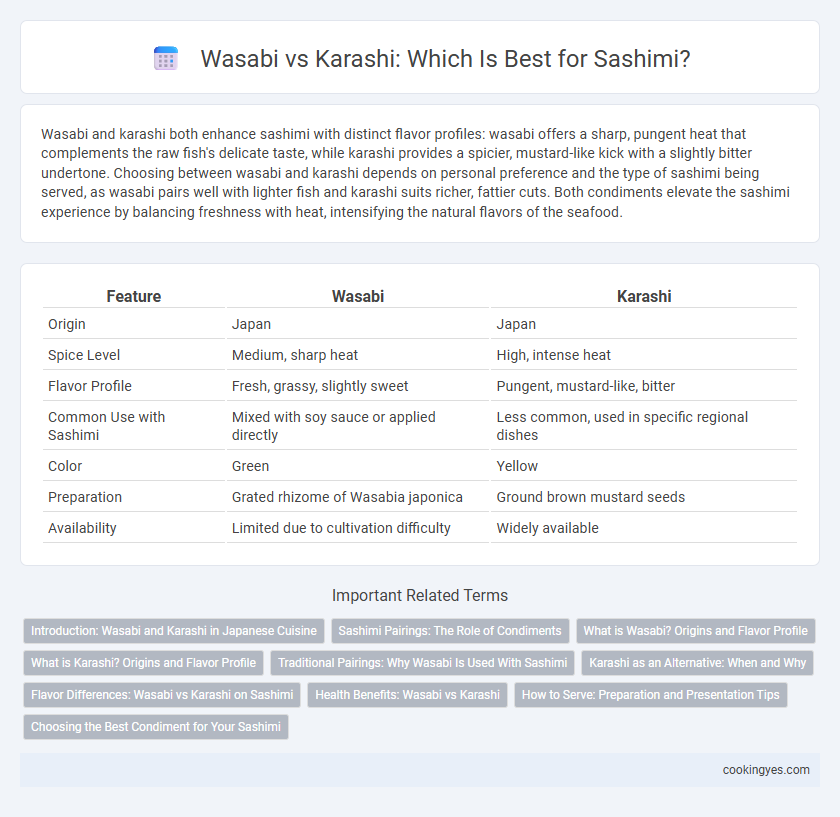Wasabi and karashi both enhance sashimi with distinct flavor profiles: wasabi offers a sharp, pungent heat that complements the raw fish's delicate taste, while karashi provides a spicier, mustard-like kick with a slightly bitter undertone. Choosing between wasabi and karashi depends on personal preference and the type of sashimi being served, as wasabi pairs well with lighter fish and karashi suits richer, fattier cuts. Both condiments elevate the sashimi experience by balancing freshness with heat, intensifying the natural flavors of the seafood.
Table of Comparison
| Feature | Wasabi | Karashi |
|---|---|---|
| Origin | Japan | Japan |
| Spice Level | Medium, sharp heat | High, intense heat |
| Flavor Profile | Fresh, grassy, slightly sweet | Pungent, mustard-like, bitter |
| Common Use with Sashimi | Mixed with soy sauce or applied directly | Less common, used in specific regional dishes |
| Color | Green | Yellow |
| Preparation | Grated rhizome of Wasabia japonica | Ground brown mustard seeds |
| Availability | Limited due to cultivation difficulty | Widely available |
Introduction: Wasabi and Karashi in Japanese Cuisine
Wasabi and karashi are traditional Japanese condiments that enhance the flavor of sashimi, offering distinct taste profiles and heat levels. Wasabi, a pungent green paste made from the Wasabia japonica root, provides a sharp, fresh spiciness that complements the delicate raw fish. Karashi, a mustard-like condiment made from crushed brown mustard seeds, delivers a stronger, more robust heat often used in other Japanese dishes but less common with sashimi.
Sashimi Pairings: The Role of Condiments
Wasabi is the traditional condiment for sashimi, offering a sharp, pungent heat that enhances the delicate flavors of raw fish without overpowering them. Karashi, a Japanese mustard, provides a more intense, spicy kick and a slightly bitter undertone, making it a less common but interesting alternative for those seeking bolder flavor contrasts. Both condiments play a crucial role in sashimi pairings by balancing freshness and richness, with wasabi highlighting the umami and karashi adding complexity to the taste experience.
What is Wasabi? Origins and Flavor Profile
Wasabi, a pungent green paste derived from the rhizome of the Wasabia japonica plant native to Japan, offers a sharp, spicy heat that quickly dissipates, enhancing sashimi's delicate flavors without overpowering them. Known for its grassy, slightly sweet undertones, wasabi acts as a natural antimicrobial, complementing raw fish while providing a distinctive, aromatic punch. Its rarity and cultivation challenges make authentic wasabi a prized condiment, distinct from the often-used horseradish-based substitutes.
What is Karashi? Origins and Flavor Profile
Karashi is a Japanese mustard paste with a sharp, pungent flavor that offers a distinct heat compared to the wasabi commonly served with sashimi. Originating from the seeds of the Brassica juncea plant, Karashi has been used in Japanese cuisine for centuries, often enhancing dishes with its bold spiciness and slightly bitter undertones. Unlike wasabi's fresh, grassy heat, Karashi delivers a more intense, sinus-clearing punch that complements the delicate taste of sashimi in a unique way.
Traditional Pairings: Why Wasabi Is Used With Sashimi
Wasabi is traditionally paired with sashimi because its sharp, pungent flavor enhances the natural taste of raw fish without overpowering it, while its antimicrobial properties help reduce the risk of foodborne illness. Unlike karashi, a spicy Japanese mustard typically used with cooked dishes, wasabi's fresh heat complements the delicate texture and subtle flavors of sashimi. This unique combination elevates the overall dining experience, maintaining balance and authenticity in traditional Japanese cuisine.
Karashi as an Alternative: When and Why
Karashi serves as a bold alternative to wasabi for sashimi, especially favored in regions where mustard-based condiments complement the fish's flavor without overpowering it. Its sharp, pungent heat enhances rich sashimi varieties like mackerel and yellowtail, providing a distinct contrast to wasabi's earthy and sinus-clearing profile. Karashi is preferred when a milder, more lingering spice is desired, or in culinary traditions emphasizing mustard seeds over horseradish-based heat.
Flavor Differences: Wasabi vs Karashi on Sashimi
Wasabi offers a sharp, pungent heat that quickly clears the nasal passages, enhancing the delicate flavors of sashimi without overpowering the fish. Karashi, a Japanese mustard, delivers a more robust, lingering spiciness with a slight bitterness that adds a contrasting depth to sashimi's mild taste. Choosing between wasabi and karashi depends on whether you prefer a bright, fleeting heat or a bold, persistent spice to complement your sashimi experience.
Health Benefits: Wasabi vs Karashi
Wasabi contains compounds like isothiocyanates that exhibit antimicrobial and anti-inflammatory properties, supporting digestive health and potentially reducing risks of certain infections when consumed with sashimi. Karashi, a type of Japanese mustard, is rich in glucosinolates and antioxidants that promote metabolism and may aid in detoxification processes. Both wasabi and karashi contribute distinct health benefits, making them valuable accompaniments to sashimi for enhancing flavor while offering nutritional advantages.
How to Serve: Preparation and Presentation Tips
When serving sashimi, wasabi is traditionally placed on the side or lightly dabbed onto the fish to enhance its fresh, delicate flavor without overpowering it. Karashi, a sharp Japanese mustard, is less common but can be mixed with soy sauce for a spicier dipping option that complements richer cuts like tuna belly. Present sashimi on chilled plates with garnishes such as shiso leaves and finely shredded daikon to balance the presentation and provide refreshing palate cleansers alongside wasabi or karashi.
Choosing the Best Condiment for Your Sashimi
Wasabi offers a sharp, pungent heat that complements sashimi by enhancing the fish's delicate flavors without overpowering them. Karashi, a Japanese mustard, provides a more intense, slightly bitter spiciness that can mask subtle sashimi tastes but adds a bold contrast. Choosing between wasabi and karashi depends on whether you prefer to highlight the sashimi's natural freshness or introduce a stronger, more pronounced spice to your dining experience.
Wasabi vs Karashi for Sashimi Infographic

 cookingyes.com
cookingyes.com